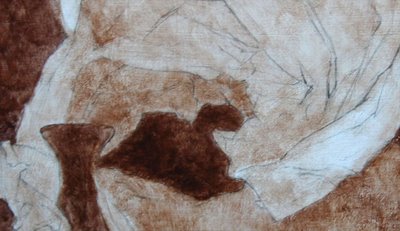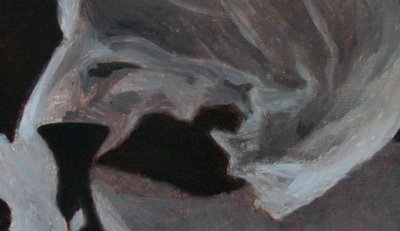full size: 18 x 24 inches
oil on panel
Here are earlier stages of this section:
This first stage is the underpainting and you can still see the graphite line drawing showing through the thin wash underpainting:
Next I did a rough "closed" underpainting -using white instead of the white of the panel. It got more refined than this but still I consider it an underpainting, thinking only in value and using a very limited palette:
Below is the first stage of the overpainting, where I am using a full spectrum of colors, and no black at all, to get a richer, more colorful range of greys. Here I am making what I think of as a "bed layer" - much more refined than the underpainting, but nowhere near the final level of detail. I'm not trying to paint to a finish, I'm just putting down whatever I think will help me in the final stages.
On to the final layers. At this point I am trying to achieve the highest level of finish possible in a very small area of the painting for every session. At a certain point I can see what I need to do to push the realism further, but I have to wait for the layer to dry before I can do more layers:
Below I am working completely in glazes, using honey-consistency glazing medium with just dark, transparent paints, and occasionally bringing a light area just a bit higher. This looks pretty similar to the previous stage, but it represents many more hours of work. This is the final push for the most impact I am capable of achieving with the paint.
I am also continuing to learn how discerning the human eye is, that a tiny whisper of different value or hue between two adjoining shapes makes a clearly discernible edge. I am constantly experimenting with how subtle a difference I can make that will still read as a difference, and describe form. In the shadowy areas of the wax paper we can see a lot of sculpted form and transparency within a very low value range - dark to black, with just little glimmers for highlights.
It's fun to try to emulate that effect, nudging hues and values around in tiny steps to describe the forms.